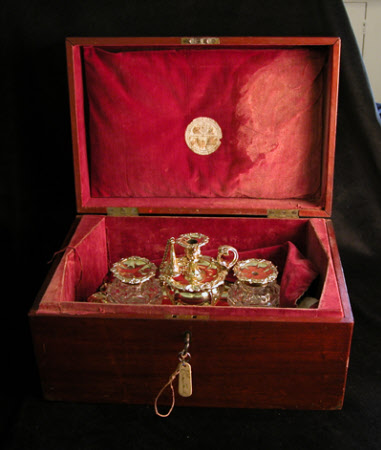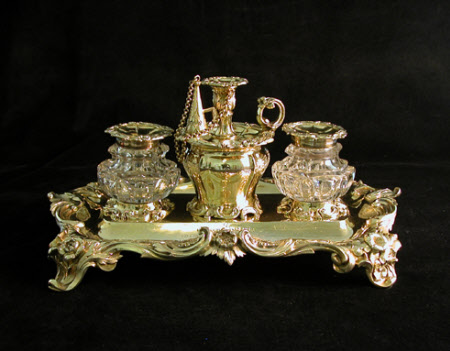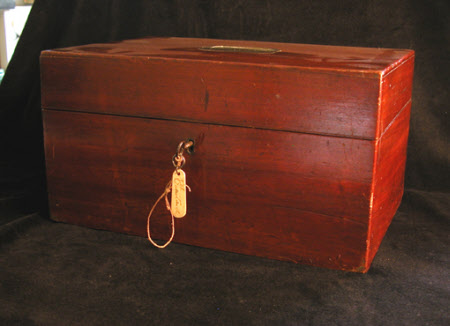Inkstand
Edward Barnard & Sons (fl.1829 - 1977)
Date
1838 - 1839
Materials
Silver-gilt, sterling; glass
Measurements
15.3 x 32.5 x 22.6 cm; Weight 1305 g
Place of origin
London
Order this imageCollection
Anglesey Abbey, Cambridgeshire
NT 516457
Summary
An inkstand with royal associations, silver-gilt (sterling), mark of Edward Barnard & Sons, London, 1838/9. The shaped rectangular base is raised, with the four feet, border and two integral handles embossed and chased with scrolling foliage and flowers. The depression for pens at the front is inscribed: ‘THE GRACIOUS GIFT/ Of/ Queen Victoria/ TO CHARLES DUMERGUE ESQRE/ in Testimony of Her Majesty’s sense of/ HIS PROFESSIONAL SKILL AND ABILITY’; the depression at the back is engraved with the royal cypher. In the centre stands a fluted baluster-shaped pot with applied scrolling foliage base which is attached to the stand by two nuts. The pot’s cover is in the form of a small chamberstick. It is raised and applied with a flange, cast scroll handle, and stem to the sconce which is decorated with acanthus leaves. The rim of the chamberstick and the detachable nozzle are applied with borders of scrolling foliage and flowers. The chained conical snuffer is embossed with laurel leaves and berries. On either side of the central pot cast circular scrollwork sockets are attached by a pair of nuts; they hold cut glass bottles; one for ink, the other for water to clean the pen . Each baluster-shaped bottle has a silver-gilt band round its neck. The dished and slightly fluted pull-off silver-gilt covers are applied with borders of scrolling foliage and flowers; the underside is soldered to a reeded flange; one cover is pierced with three holes, the other with one. Heraldry: Engraved with the royal cypher within the Garter motto, crown above. Hallmarks: Fully marked on the underside of the stand: ‘EE/B/JW’ (Edward Barnard and Sons*), lion passant (sterling), leopard’s head (London), ‘C’ (1838/9), and monarch’s head (duty mark); on the taperstick’s foot ring: monarch’s head, lion passant, ‘C’ and leopard’s head; on the nozzle: monarch’s head, and lion passant; and on the snuffer: monarch’s head, lion passant, and ‘C’; on the mount of each glass inkwell: monarch’s head, lion passant, ‘C’, and leopard’s head; on the flange of each inkwell’s cover: ‘EE/B/JW’, monarch’s head, lion passant, and ‘C’. * Arthur Grimwade: London Goldsmiths 1697-1837, 1990, p 52, no 575. Scratch weight: None
Full description
NOTES EDWARD BARNARD & SONS SYSTEM OF MARKING THEIR SILVER Edward Barnard & Sons marked the silver which they held in stock with the cost of manufacture and the stock number. The base of the inkstand is stamped with the letter ‘K’ for the cost, and scratched with the number ‘1354’ for the stock number. [1] The Barnards also produced a larger and heavier version of this inkstand, which lacks the central pot and chamberstick, and has a slightly more ornate border. There is an example at the National Trust’s property, Ickworth. [2] It was made in 1857/8, and is stamped ‘B’ and ‘993’. The code for the cost has yet to be deciphered, but many of the Barnards’ day books, pattern books and price books are held at the Victoria & Albert Museum, and there are occasions when it is possible to identify the original design, supplier (as the Barnards bought in, as well as manufactured silver), and buyer. [1] John Fallon: The House of Barnard, The Journal of The Silver Society, 2009, No 26, London, pp 42-62 [2] James Rothwell: Silver for Entertaining: The Ickworth Collection, London, 2017, pp 2220-221, no 126 NOTES ON CHARLES DUMERGUE Charles John Joli Dumergue (1777-1852) was appointed Surgeon Dentist to Queen Victoria on her accession in 1837. He was Surgeon Extraordinary and Surgeon Dentist to George IV, and Surgeon Dentist to King William IV; he was also dentist to Princess Victoria’s parents, the Duke and Duchess of Kent. In general Dentists to the Household drew a regular annual salary. Dumergue was given a stipend of 100 guineas on his appointment to George IV which was ‘not intended to preclude such charges as Mr. Dumergue may find occasion to make for extra services’. However, this was later stopped and he was paid for his attendances as they were required. [3] His French parents were Joseph de Joly and Therese Dumergue, however, he was raised by his maternal uncle, Charles Francois Dumergue (1739-1814), who also served as Dentist to the royal family, including George, Prince of Wales, and Frederica, Duchess of York. It is thought that the young Charles changed his surname in deference to his uncle. He is listed in the Royal Kalendar until 1874, although a descendant states that he died on 22 April 1852. When he was naturalised in 1793 by Act of Parliament, he was living in the Parish of St. George, Hanover Square. The marriages of his three daughters (Maria Theresa 1.10.1825, Fanny 8.11.1828, and Letitia 30.3.1833) were recorded in the registers of St. George’s, but by 1846 he was living in Portland Square. [3] Information provided by the Royal Archives, Windsor Castle Jane Ewart, 2025
Provenance
Charles Dumergue (Urban) Huttleston Rogers Broughton, 1st Baron Fairhaven (1896-1966) bequeathed by Lord Fairhaven to the National Trust along with the house and the rest of the contents. National Trust
Credit line
Anglesey Abbey, the Fairhaven Collection (National Trust)
Makers and roles
Edward Barnard & Sons (fl.1829 - 1977), goldsmith



